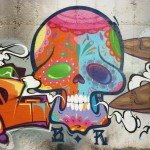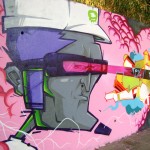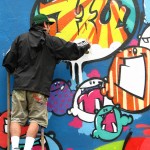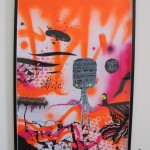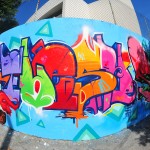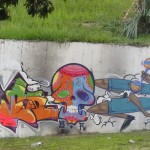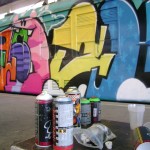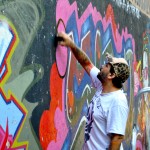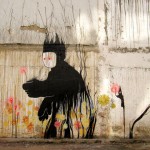By Nathan M. Walters, Senior Contributing Reporter
RIO DE JANEIRO, BRAZIL – Graffiti (from the New York City tradition) only started to appear in Rio in a big way during the late Nineties, but it did not take long for the city earn a reputation as one of the most tolerant of the work. Around this time a group of friends operating a ‘zine’ focused on drawing took to the streets, and in so doing set the foundation for the rapidly evolving street art movement in Rio.

Fleshbeck Crew, composed of artists BR, Toz, Pia’, SWK, Rod, and Krrank, pioneered the graffiti movement in Rio, and still remain some of the most respected figures in the scene.
Working together on the Fleshbeck Zine, the crew took shape honing their skills in sketchbooks before transforming the streets. “At that time we were very influenced by images coming out of the [U.S.]. Even before hip-hop we were tuned into the representation of urban life from films like ‘The Warriors’.”
The term ‘crew’ refers to a collection of graffiti writers that work together, usually a collection of friends and like-minded artists that are intent on furthering their art with the support of a close-knit community. Fleshbeck Crew was one of the original groups working in Rio.
They, along with a few others (e.g., Nação Crew), still work as a team to produce some of the city’s most exciting work in Rio. The group’s ability to remain cohesive over a span of time that has seen graffiti change from vandalism to collected art is a testament to the shared vision of the founding members.

“Graffiti became hip, everyone was doing it,” states a smiling BR, one of the founding members of Rio’s Fleshbeck Crew. “But in the Nineties there was nothing, after ‘Celacanto Provoca Maremoto’ and Profeta Gentileza, there was mainly pichação. Our work introduced the city to this type of graffiti and we are still obsessed with the potential. That’s why we are still around, this isn’t a fad for us, it’s our passion.”
The Crew still works on projects as a team, but has also found success in individual projects. Many of the founding members (BR, Toz) have had exhibitions in Rio’s Galeria Movimento and Krrank has gained international attention for his photo and video records of graffiti in Rio. The crew has also participated together in key art events in Brazil, including: Fabulosas Desordens (2007) and the São Paulo Biennial (2010).
Pia’, responsible for some of the most memorable work in Rio, became obsessed with graffiti shortly after Fleshbeck premiered on the street. He mentioned the importance of Fleshbeck, “When I first saw their work I was hooked, it changed the game in Rio.”
The street art scene, born out of the graffiti tradition, continues to change rapidly in Rio. For some it is still on a catch-up mission to its São Paulo counterpart, yet with the Carioca creativity the city is quickly evolving into one of the most vibrant street art scenes in the world.





